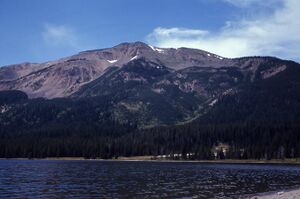Earth:Yellowstone Plateau Volcanic Field
| Yellowstone Plateau Volcanic Field | |
|---|---|
 Mount Sheridan, the highest peak in the Yellowstone Plateau Volcanic Field, from Heart Lake | |
| Highest point | |
| Elevation | 10,313[1] ft (3,143 m) |
| Coordinates | [ ⚑ ] 44°28′16″N 110°30′07″W / 44.471031°N 110.501862°W |
| Geography | |
| Location |
|
| Parent range | Rocky Mountains |
| Topo map | USGS Yellowstone National Park |
| Geology | |
| Age of rock | ~2,080,000–70,000 years[2] |
| Mountain type | Complex volcano, volcanic plateau and volcanic field[3] |
| Last eruption | approximately 631,000 years ago (caldera-forming); 70,000 years ago (in the caldera) |
| Climbing | |
| Easiest route | Hike/auto/bus |
The Yellowstone Plateau Volcanic Field, also known as the Yellowstone Supervolcano or the Yellowstone Volcano, is a complex volcano, volcanic plateau and volcanic field located mostly in the western U.S. state of Wyoming but also stretches into Idaho and Montana. It is a popular site for tourists.
The plateau developed through three volcanic cycles spanning two million years that included some of the world's largest known eruptions. The eruption of the >2,500 km2 (970 sq mi) Huckleberry Ridge Tuff about 2 million years ago created the more than 75 km (47 mi) long Island Park Caldera. The second cycle concluded with the eruption of the Mesa Falls Tuff around 1.3 million years ago, forming the 25 km (16 mi) wide Henry's Fork Caldera at the western end of the first caldera. Activity subsequently shifted to the present Yellowstone Plateau and culminated 630,000 years ago with the eruption of the >1,000 km2 (390 sq mi) Lava Creek Tuff and the formation of the present 45 km × 75 km (28 mi × 47 mi) caldera. Resurgent doming then occurred at both the NE and SW sides of the caldera and voluminous 1,000 km2 (390 sq mi) intracaldera rhyolitic lava flows were erupted between 150,000 and 70,000 years ago. Phreatic eruptions produced local tephras during the early Holocene. The caldera presently contains one of the world's largest hydrothermal systems including the world's largest concentration of geysers.[4] Much of the plateau is located within Yellowstone National Park.
References
- ↑ "Yellowstone Plateau". Peakbagger.com. https://www.peakbagger.com/range.aspx?rid=14403.
- ↑ USGS. "The evolution of the Yellowstone Plateau Volcanic Field: Past, present, and future!". United States Geological Survey. https://www.usgs.gov/center-news/evolution-yellowstone-plateau-volcanic-field-past-present-and-future.
- ↑ "Yellowstone". Smithsonian Institution. https://volcano.si.edu/volcano.cfm?vn=325010.
- ↑ "Volcanic History of the Yellowstone Plateau Volcanic Field". U.S. Geological Survey. http://volcanoes.usgs.gov/yvo/history.html.
[ ⚑ ] 44°28′16″N 110°30′07″W / 44.471031°N 110.501862°W
 |

